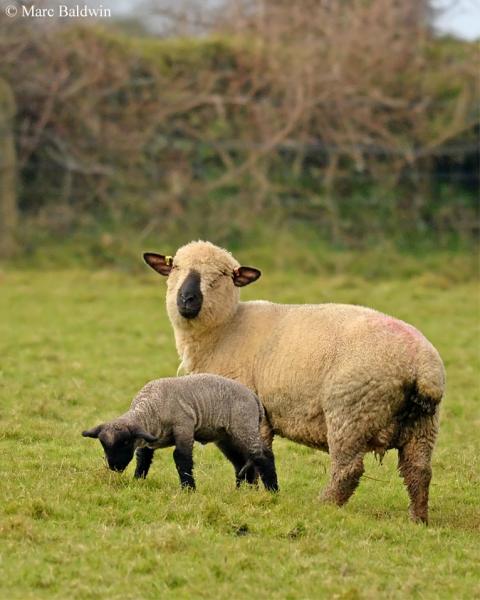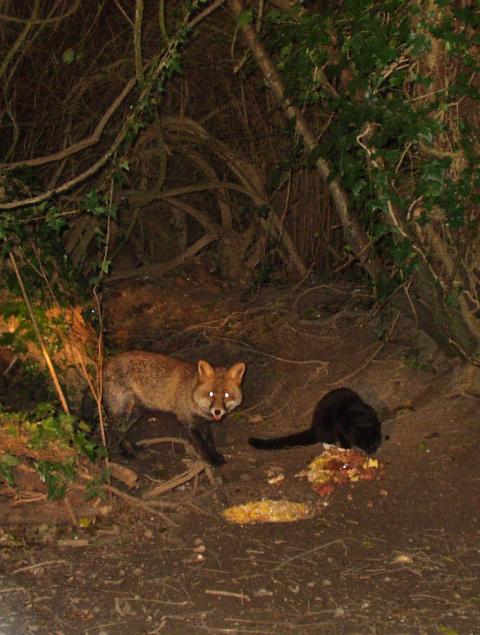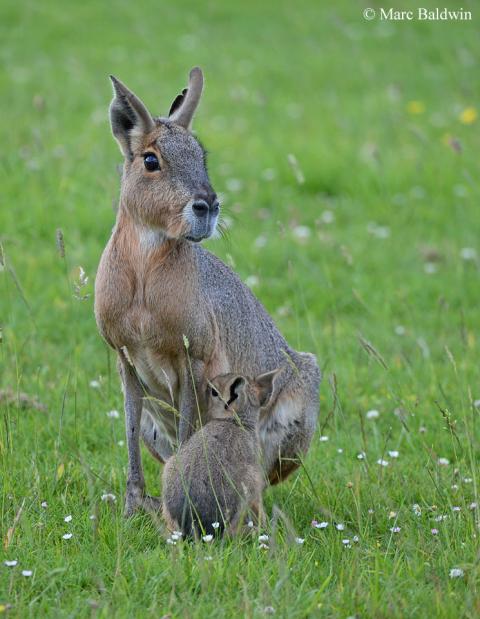Red Fox Diet - Pets & Livestock
When discussing species in the diet of the Red fox, brief mention should be made of their interaction with pets and livestock. Both subjects are covered elsewhere on this site in greater detail (see: QAs and Interaction with other Species), so I only summarise here.
Livestock

Foxes have a notorious reputation for taking livestock; most often this involves chickens and lambs, but there is some evidence that they will occasionally take piglets and there have been sporadic reports of foxes taking pony foals, particularly -- according to Brian Vezey-Fitzgerald -- in the New Forest, although I know of nobody else who has ever found evidence for the latter. How many pets, lambs, piglets and foals are killed by the fox and how many are scavenged after death is unknown.
Most of the science suggests that livestock and pet losses to foxes are small, but even the loss of a single pet can cause considerable grief and the loss of a single lamb can represent a significant dent in a farmer’s income. One Cornish farmer told me that every time a fox takes a lamb it’s like taking two £50 notes out of his wallet and setting fire to them. Similarly, telling someone who has just had their rabbit or lamb taken by a fox that studies show how only about 5% of a fox's diet includes livestock offers no comfort.
One thing is clear, however: good husbandry practices (lambing inside, for example) along with targeted fox control can significantly reduce the likelihood of any losses occurring. That said, simply having a fox around -- even in the same field as your sheep -- is not necessarily always going to end badly for the lambs. In an excerpt of a letter printed in Mammal News during 2007, self-employed market gardener and poultry breeder Roy Allerby from Cheshire described one such interaction he witnessed while fishing on a remote lake in the Welsh mountains:
"I was disguised with three clumps of sedge, so I was not conspicuous. A fox came over the top of the hill and trotted straight up to a ewe with a lamb not much bigger than a large rabbit. The fox and the ewe smelt noses quite amicably, the fox did not look at the lamb and then trotted off."
In both urban and rural environments, foxes will occasionally breach smallholding security to gain access to chickens, ducks, pet rabbits, guinea pigs, etc. How often such events occur is unknown – there are no recent statistics that I am aware of (most that are frequently quoted in the media are based on surveys conducted in the late 1970s and early 1980s) and in many cases people return to find a scene of destruction, but do not see the perpetrator. The problem is accentuated because it is often difficult to be sure of the animal responsible; that it was a fox is often only assumed.
Dogs and cats
I know of instances where cats and dogs have killed other people’s pets and, in some instances the owners have told me that, had they not seen the attack (or in one case, come home to find the dog still in the chicken coop) they would have assumed a fox was to blame. In my experience people often do not consider stray dogs as a possible culprit when they return home to find the remains of a pet, but the 2017 Stray Dog Report published by the Dogs Trust charity found that just over 66,000 strays were collected between April 2016 and March 2017 by the 309 local authorities in the UK who responded to the survey. Numbers are falling, but these data still suggest an average of 181 dogs picked up each day. Furthermore, this only accounts for those collected by dog wardens, and not those that are never caught or only escaped for a few hours/days.

Similarly, badgers, stoats, mink and birds of prey can cause havoc in a chicken run, all leaving similar destruction in their wake, which makes positively identifying the culprit very difficult. This is not a case of "special pleading" for the fox – foxes do occasionally kill pets, plain and simple. The point is that, when considering the best husbandry practice for the animals in your care, more than just foxes need to be considered. In the end, if you plan to keep pets in your garden, they must be securely housed (see Fox Deterrence) – we should not expect a predator (be it a fox, a cat, a dog or a badger) to turn down an easy meal just because the prey is owned by a human. They have no sense of right or wrong; to them it’s all just food. I, after all, sometimes get in from work too tired to ‘faff’ about making dinner and reach for a frozen pizza or microwave meal because it’s easier; I’m sure I’m not alone, either.
When we think of pets falling foul of foxes, we tend to picture a rabbit or chicken, but there are occasional reports of foxes attacking cats and small dog breeds, such as Chihuahua (see QA). How often such incidents happen and the reason(s) behind them isn't known, and it remains a highly controversial subject; I know some who categorically refuse to believe that it happens at all. Personally, I have no doubt that such incidents happen, but I do not believe that they are common; nor do I think foxes pose a significant threat to cats. This is a view that appears broadly shared by most people with experience watching and/or studying foxes.
A recent questionnaire aimed at assessing the general public’s perception of urban foxes in Estonia, a country in which urban foxes have become significantly more common since a successful rabies vaccination campaign, recorded some instances of foxes chasing and attacking cats. In their review of the data, a team at the University of Tartu led by Liivi Plumer noted:
“Therefore it is possible that urban foxes predate on domestic pets, but the results of this study suggest that the rate of such incidents is low.”
My own personal experience and that of many others is that, when cats and foxes meet, the cat either chases the fox off (and I have even seen video of a kitten chasing an adult fox away) or the two ignore one another. More interestingly, I have received e-mails from readers describing what can only be play behaviour between foxes and both cats and dogs. Bridget MacCaskill, in her 2001 book The Blood is Wild, described how a vixen cub she was rearing struck up a friendship with her black tom cat; the two apparently often slept and hunted together in the enclosure and the cat would sometimes even steal the vixen’s food. Similarly, a friend of mine sent me some photos of a kitten that appeared to be living with a group of foxes in Surrey, before being caught by an animal charity and re-homed in December 2005.

Interestingly, the relationship between foxes and dogs/cats can extend beyond playmates to the latter being surrogate parents to abandoned cubs. Indeed, in a 1935 paper to the Proceedings of the Zoological Society of London, Ian Rowlands and Alan Parkes note that:
"... fox cubs are reared quite well by cats ...".
Similarly, in his 1990 book Free Spirit, Michael Chambers described how his mongrel dog 'Sniff' became a surrogate mother for a very young fox cub, grooming it, playing with it and driving back inquisitive cows that got too close. Nonetheless, foxes and mature cats are approximately the same size and hunt for the same prey (small rodents and birds), so the potential for competition, and hence conflict, is always there. Moreover, cats occasionally kill fox cubs, presumably making foxes more wary (possibly hostile?) towards them during the start of the cubbing season. In early June 2012, I had the pleasure of watching a dog fox that frequently visited the garden of our old flat interact with one of the neighbourhood cats. The following is taken from my notes on the encounter:
"Fox in garden in drizzle sitting half-way along hedge. Cat appeared from carpark and moved quickly around (hugging CVTS office wall) and through flowerbed, past bedroom window and stopped alongside bush outside living room window. Fox watched cat pass and gave chase once cat had gone out of its view (i.e. reached bush). Fox walked up and down along bush outside bedroom window with back arched rubbing flank against bush (very similar to how a cat rubs against a human). Fox approached cat submissively (arched back, ears flat, mouth open and diverted gaze) and cat hissed and swiped at fox with front right paw; fox leapt back and re-scent-marked bedroom bush. Fox and cat looked at each other for a minute-or-so but fox made no further attempt to interact with cat, and didn't approach cat again. Cat followed fox out of garden."
In Australia, several studies suggest that feral cats are probably subordinate to foxes and fox control programmes appear to increase feral cat abundance. In one study on western Australia’s Peron Peninsula, for example, virtual extermination of foxes resulted in the feral cat population increasing three-fold, from 300 to 950. In a 2017 paper to the journal PLOS One, a team led by Robyn Molsher at the DEWNR report the findings of their study on the effects of fox control on the biology of the feral cats on the foreshores of Lake Burrendong in central New South Wales, Australia.
The researchers didn’t observe any increase in cat abundance when fox numbers were reduced, but they did note that the cats changed their habitat use; grassland habitats were used more during the night and open forest habitat during the daytime when foxes were not present. There was also a modest shift in diet to include more rabbits in the absence of foxes. There were some instances of foxes killing radio-tagged cats, attributed as the predator in 18% of the deaths, but no cat remains were found in any of the 343 fox droppings or 255 stomachs collected over the course of the study. Given that the diets of foxes and feral cats overlapped by 70-80%, depending on season, competition and predation was expected, but as Molsher and his colleagues point out:

“On average, foxes were therefore less than twice the mass of cats in the Burrendong region. Thus, in addition to the subtle differences in diet noted above, the fact that foxes were not much larger than cats could explain the lack of evidence we found for intraguild predation.”
Taste for the exotic
There are also occasional reports of foxes attacking zoo animals and an inspection report of London Zoo stated that 11 penguins had been killed in a fox attack in the early hours of 18th March 2009. The Zoological Society of London also told The Independent newspaper, in October 2010, that foxes had attacked two mara (Dolichotis patagonum), a free-range chicken and a flamingo (Phoenicopterus roseus) between 2007 and 2010, although it's not clear whether these occurred at London or Whipsnade. Foxes have been reported to have killed penguins at both London Zoo (2009) and Whipsnade Zoo in Bedfordshire (2012). In their book Urban Foxes, however, Stephen Harris and Phil Baker refer to a report of a fox walking down a street carrying a flamingo, suggesting it may have been taken from London Zoo.